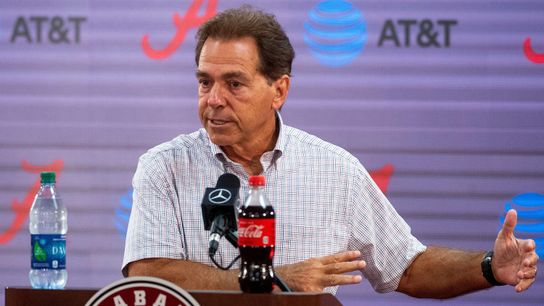Both Alabama coach Nick Saban and Texas A&M head man Jimbo Fisher emphasized that their teams don't do it and never are coached to do it.
Ole Miss coach Lane Kiffin did not go that far, but Kiffin endorsed tangible penalties for the matter.
What is it? The widely accepted act of “faking” injuries or exaggerating their extent to disrupt or stop the flow of a game – most often on the defensive side of the ball in college football.
“It's not something we've ever done here,” Saban said Wednesday during the Southeastern Conferences' weekly coaches' call.
Fisher emphasized that the act is “not something we teach” and “not something we do” at Texas A&M.
The issue isn't a new one, its prevalence seemingly springing up around the same time as the onset of rapid-tempo offenses within the past decade, but it's now front-and-center again for its apparent – or alleged – occurrences in several high-profile games this fall.
Iowa coach Kirk Ferentz questioned the veracity of some injury situations in his Hawkeyes' comeback-win against Penn State and noted it was maybe the second time in 23 years of coaching that he questioned what happened in that regard; James Franklin fired back at Ferentz and Iowa.
Saban even pointed to an instance late in the Tide's 31-29 win last month at Florida.
Most recently, Ole Miss defenders dropped to the turf double-digit times last Saturday night in Neyland Stadium as the Rebels held on for a 31-26 win.
“I said when it was talked about, and they (conference, rules officials) said, 'Well, we'll warn people, send a letter to the A.D. and the head coach,'” Kiffin shared on the SEC call. “OK, well, I can tell you I don't think you're going to really stop that until you get (to a point where), 'Hey, the guy has to stay out for so many plays.' You've got to, like anything, there's got to be a penalty to it.
IT IS EVERY SINGLE PLAY SOMEONE IS GETTING HURT📢📢📢📢#OleMiss #Tennessee pic.twitter.com/ZorRc3Crje
— CFB Country (@_CFBCountry) October 17, 2021
“If you really want to change it, let the conference go review it and look at the film and when they deem it to be an obvious faking of an injury, there's a penalty, a fine. I can promise you it would never happen anywhere.”
Saban said the practice – oftentimes defensive linemen crumple to the turf until athletics trainers can assist them to the sidelines – both slows down the game and likely is not good for the product of college football.
“When players get tired, they’re more susceptible to getting injured, probably,” Saban said. “And you don’t have enough call timeouts to call timeout.
“So I understand why some people do it.”
Saban then pointed to that early-season game at Florida – though he said he was unsure if the injury was real or faked.
“We had a situation (at Florida) where we’re trying to take the air out of it,” Saban said, of melting game clock, “and one of their players goes down to stop the clock. And maybe it was legit. I don’t really know.”
The injuries/faux injuries do not impact the time left on the game clock, Saban noted. The maneuver merely facilitates additional time for a defense to make substitutions and try to find its proper alignments.
SEC Commissioner Greg Sankey has publicly stated that it is a matter the league is further exploring.
Shame on Ole Miss for faking injuries amirite. Watch the coach at the bottom of the screen lol pic.twitter.com/adrV3W6fLF
— Eli (@EliPerkins3) October 18, 2021
